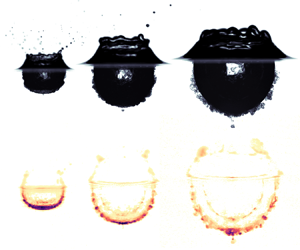Crossref Citations
This article has been cited by the following publications. This list is generated based on data provided by
Crossref.
Villermaux, E.
2022.
Equilibrated crater: fragmentation and mixing.
Journal of Fluid Mechanics,
Vol. 942,
Issue. ,
Wang, Hui
Liu, Shuo
Bayeul-Lainé, Annie-Claude
Murphy, David
Katz, Joseph
and
Coutier-Delgosha, Olivier
2023.
Analysis of high-speed drop impact onto deep liquid pool.
Journal of Fluid Mechanics,
Vol. 972,
Issue. ,
Zheng, Yajing
Wu, Zengnan
Hou, Ying
Li, Nan
Zhang, Qiang
and
Lin, Jin-Ming
2023.
Microfluidic Engineering of Crater–Terrain Hydrogel Microparticles: Toward Novel Cell Carriers.
ACS Applied Materials & Interfaces,
Vol. 15,
Issue. 6,
p.
7833.
Liu, Changwen
Wu-Wang, Hongzhi
Zhang, Yousheng
and
Xiao, Zuoli
2023.
A decoupled mechanism of interface growth in single-mode hydrodynamic instabilities.
Journal of Fluid Mechanics,
Vol. 964,
Issue. ,
Lherm, V.
and
Deguen, R.
2023.
Velocity field and cavity dynamics in drop impact experiments.
Journal of Fluid Mechanics,
Vol. 962,
Issue. ,
Singh, Sukhmander
Vidhani, Bhavna
Yogi, Sonia
Tyagi, Ashish
Kumar, Sanjeev
and
Kumar Meena, Shravan
2023.
Plasma Science - Recent Advances, New Perspectives and Applications.
Allibert, L.
Landeau, M.
Röhlen, R.
Maller, A.
Nakajima, M.
and
Wünnemann, K.
2023.
Planetary Impacts: Scaling of Crater Depth From Subsonic to Supersonic Conditions.
Journal of Geophysical Research: Planets,
Vol. 128,
Issue. 8,
Kayal, Lohit
and
Dasgupta, Ratul
2023.
Jet from a very large, axisymmetric, surface-gravity wave.
Journal of Fluid Mechanics,
Vol. 975,
Issue. ,
Fudge, Ben D.
Cimpeanu, Radu
Antkowiak, Arnaud
Castrejón-Pita, J. Rafael
and
Castrejón-Pita, Alfonso A.
2023.
Drop splashing after impact onto immiscible pools of different viscosities.
Journal of Colloid and Interface Science,
Vol. 641,
Issue. ,
p.
585.
Liu, Changwen
Zhang, Yousheng
and
Xiao, Zuoli
2023.
A unified theoretical model for spatiotemporal development of Rayleigh–Taylor and Richtmyer–Meshkov fingers.
Journal of Fluid Mechanics,
Vol. 954,
Issue. ,
Kriaa, Quentin
Landeau, Maylis
and
Le Bars, Michael
2024.
Influence of planetary rotation on metal-silicate mixing and equilibration in a magma ocean.
Physics of the Earth and Planetary Interiors,
Vol. 352,
Issue. ,
p.
107168.
Lherm, Victor
Nakajima, Miki
and
Blackman, Eric G.
2024.
Thermal and magnetic evolution of an Earth-like planet with a basal magma ocean.
Physics of the Earth and Planetary Interiors,
Vol. 356,
Issue. ,
p.
107267.
Wu, Zengnan
Zheng, Yajing
Lin, Ling
Lin, Yongning
Xie, Tianze
Liao, Wenjun
Chen, Shiyu
Zhang, Yingrui
and
Lin, Jin-Ming
2024.
Open aerosol microfluidics enable orthogonal compartmentalized functionalization of hydrogel particles.
Matter,
Vol. 7,
Issue. 10,
p.
3645.
Chashechkin, Yu. D.
2024.
The Laws of the Matter Distribution in a Colored Free-Falling Drop in a Transparent Target Fluid (Review).
Fluid Dynamics,
Vol. 59,
Issue. 6,
p.
1693.
Gourmandie, Vincent
Pierre, Juliette
Leroy, Valentin
and
Derec, Caroline
2024.
Bubble entrapment by drop impact: Combined effect of surface tension and viscosity.
Physical Review Fluids,
Vol. 9,
Issue. 9,
Maller, Augustin
Landeau, Maylis
Allibert, Laetitia
and
Charnoz, Sébastien
2024.
Condition for metal fragmentation during Earth-forming collisions.
Physics of the Earth and Planetary Interiors,
Vol. 352,
Issue. ,
p.
107199.
Luo, Lang
Tian, Yuansi
and
Li, Erqiang
2024.
Experimental study on the impact behaviors of a water drop on immiscible oil surfaces: bouncing, compound central jet formation and crater evolution.
Experiments in Fluids,
Vol. 65,
Issue. 3,
Röhlen, Randolph
Wünnemann, Kai
Allibert, Laetitia
Maas, Christian
and
Hansen, Ulrich
2025.
Impactor core breakup during impact into a magma ocean: A parameter study.
Icarus,
Vol. 431,
Issue. ,
p.
116464.
Deguen, Renaud
Huguet, Ludovic
Landeau, Maylis
Lherm, Victor
Maller, Augustin
and
Wacheul, Jean-Baptiste
2025.
Fluid dynamics of planetary differentiation.
Comptes Rendus. Physique,
Vol. 25,
Issue. S3,
p.
1.
Padhan, Nadia Bihari
and
Pandit, Rahul
2025.
The Cahn–Hilliard–Navier–Stokes framework for multiphase fluid flows: laminar, turbulent and active.
Journal of Fluid Mechanics,
Vol. 1010,
Issue. ,
